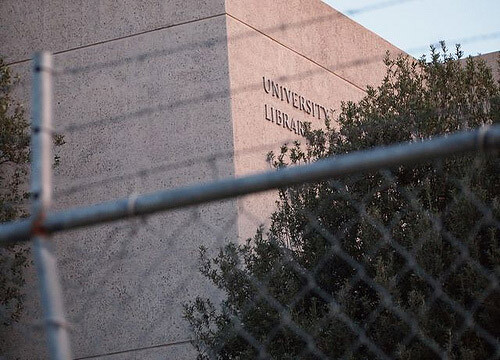The Electronic Intifada 20 April 2011

Part of the mock border wall at the University of Arizona. (No Más Muertes)
On 21 March, activists with Jewish Voice for Peace (JVP) and immigrant rights group No Mas Muertes (“No More Deaths”) assembled the wall on the University of Arizona campus, dividing the area with barbed wire and steel barriers.
Campus groups across the country have constructed smaller mock walls and checkpoints in the past, usually during Israeli Apartheid Week actions, but in a press release, students say that this was the largest mock wall yet erected in the country. The wall, they say, was aimed “to spotlight the lethal effects of US militarization, immigration and border enforcement policies in Arizona, the US and Israeli-occupied Palestine” (“Arizona Jewish students erect largest mock border wall in the US,” 21 March 2011).
Stretching “nearly four football fields’ length” at approximately 1,200 feet long, the mock wall stood for more than a week “across the main traffic center of the more-than-50,000-person University of Arizona campus.”
Student groups worked for nearly eight months to plan and construct the wall. They titled the project “Wall to Wall - Concrete Connections/Conexiones Concretas.”
JVP member Gabriel Matthew Schivone said in the press release that “We won’t let daily life continue while people are dying and suffering from abominable policies being funded with US tax dollars.”
Schivone added “We aim to disturb, to trouble our peers with the knowledge — and less than one tenth of a simulated experience — of our fellow neighbors and communities’ miserable conditions to which our privilege renders many of us to be immune, and renders the conditions themselves to be invisible. We hope to quicken the conscience of our community and shake them into action to end these abuses.”
Members of JVP and NMM published a joint statement in the Arizona Daily Wildcat, the university’s paper, after the wall was put up. “We will not stand idly by nor stay silent regarding the enormous suffering being inflicted either in our local deserts and cities, or 10,000 miles away in Israeli-occupied Palestine … [Our wall] symbolized our collective will to end global apartheid and work toward a world that truly offers justice for all,” the statement reads (“Guest Column: Mock wall aims for understanding,” 23 March 2011).
Mock wall vandalized
On 26 March, vandals attacked the section symbolizing Israel’s wall in the West Bank. The wall “was violently uprooted and strewn across the roadway … in a mesh of loose barbed wire and steel barriers,” JVP stated in a press release (“Anti-Palestinian Hate Crime at UA Mock Wall,” 26 March 2011).
“The act followed numerous threats leveled against the wall and against the organizers throughout the week,” the press release adds. JVP coordinator and graduate student Bryan James Gordon said that it was “pretty clear which element was responsible for this act of violence.”
Gordon added “I don’t believe it was [members of the anti-immigrant group] Minutemen, I don’t believe it was College Republicans, it was those motivated out of silencing the Palestinian voice or voices that present the Palestinian narrative. And we consider it a hateful act. The institutional response to call this act a ‘hate crime’ would be swift, indeed, if the target was an exhibit about anti-Semitism.”
On 30 March, South African Archbishop and human rights leader Desmond Tutu issued a statement in support of the University of Arizona mock wall and recently-launched divestment campaigns against US companies that supply equipment to the Israeli military.
In his letter, Tutu writes: “When an immigrant is criminalized in Arizona or elsewhere in the US for not having the right papers as he tries to make a living, I stand with him. When a Palestinian man stands for hours at an Israeli military checkpoint in order to get to his job and make a living, I stand with him. And I ask you to stand with me, with them, as the students are at the threshold of a new movement that seeks justice by withdrawing support for injustice” (“Archbishop Desmond Tutu Supports UA NMM Divestment Campaign, Mock Wall,” 30 March 2011).
Other campus activists launch mock wall projects
Students at several universities across the US announced that they would take part in similar mock wall actions, following the University of Arizona’s initiative.
Student activists at Brown University in Rhode Island erected a mock wall on campus on 8 April, bearing the same title as the wall at the University of Arizona. Other walls are being planned for construction at Evergreen State College, in Olympia, Washington; at University of Massachusetts Amherst; and in Albuquerque at the University of New Mexico.
In a press release, Brown University student Gavriel Cutipa-Zorn said that “we are excited to see that others have also been inspired to build similar mock walls to bind the issues, already linked at their core. This is just the beginning of a national movement that has already spanned from coast to coast” (“Students Nationwide Launch ‘Mock Wall’ Movement,” 30 March 2011).
The statement adds that a book collection, entitled Concrete Connections, “is also in the works, created by and for students, with well-known guest contributors.”

